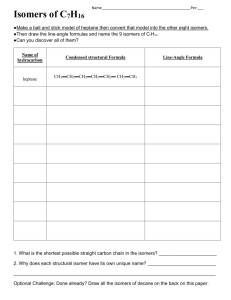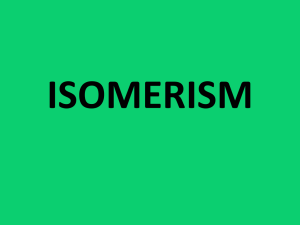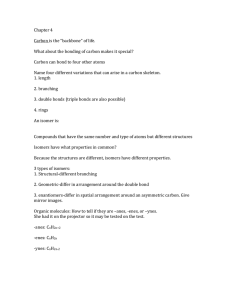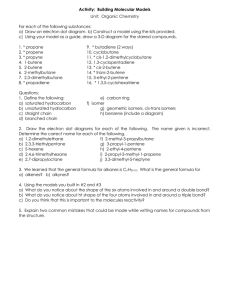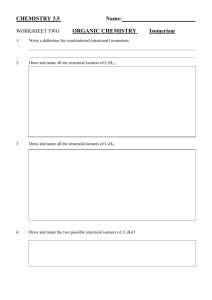Isomers and Polymers
advertisement
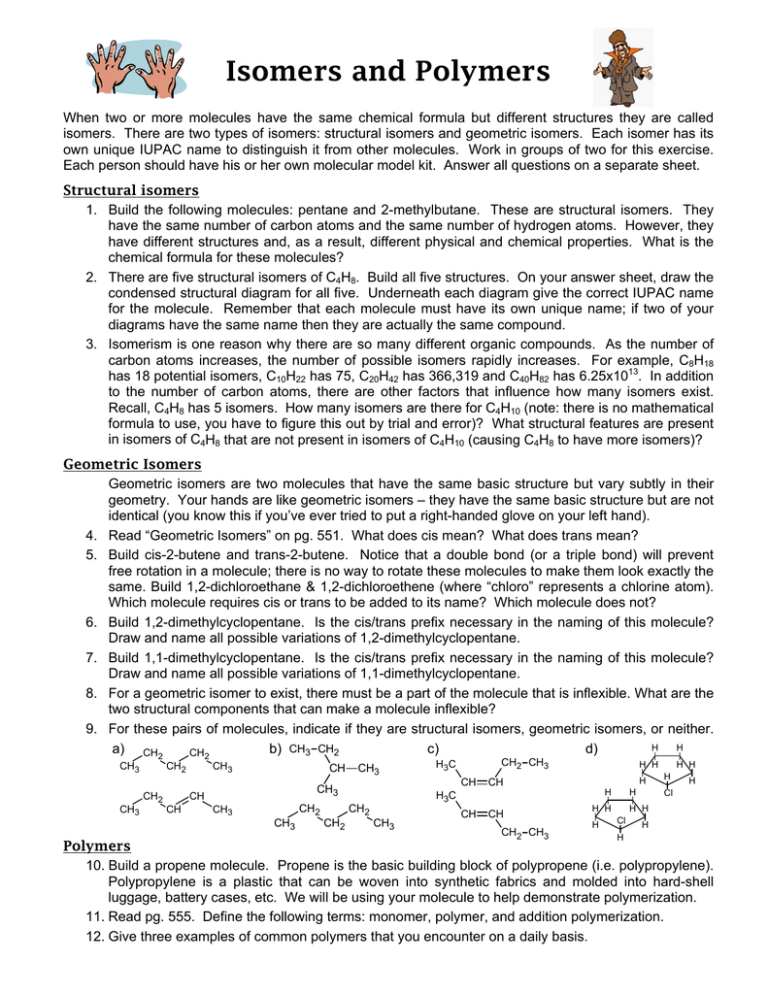
Isomers and Polymers When two or more molecules have the same chemical formula but different structures they are called isomers. There are two types of isomers: structural isomers and geometric isomers. Each isomer has its own unique IUPAC name to distinguish it from other molecules. Work in groups of two for this exercise. Each person should have his or her own molecular model kit. Answer all questions on a separate sheet. Structural isomers 1. Build the following molecules: pentane and 2-methylbutane. These are structural isomers. They have the same number of carbon atoms and the same number of hydrogen atoms. However, they have different structures and, as a result, different physical and chemical properties. What is the chemical formula for these molecules? 2. There are five structural isomers of C4H8. Build all five structures. On your answer sheet, draw the condensed structural diagram for all five. Underneath each diagram give the correct IUPAC name for the molecule. Remember that each molecule must have its own unique name; if two of your diagrams have the same name then they are actually the same compound. 3. Isomerism is one reason why there are so many different organic compounds. As the number of carbon atoms increases, the number of possible isomers rapidly increases. For example, C8H18 has 18 potential isomers, C10H22 has 75, C20H42 has 366,319 and C40H82 has 6.25x1013. In addition to the number of carbon atoms, there are other factors that influence how many isomers exist. Recall, C4H8 has 5 isomers. How many isomers are there for C4H10 (note: there is no mathematical formula to use, you have to figure this out by trial and error)? What structural features are present in isomers of C4H8 that are not present in isomers of C4H10 (causing C4H8 to have more isomers)? Geometric Isomers Geometric isomers are two molecules that have the same basic structure but vary subtly in their geometry. Your hands are like geometric isomers – they have the same basic structure but are not identical (you know this if you’ve ever tried to put a right-handed glove on your left hand). 4. Read “Geometric Isomers” on pg. 551. What does cis mean? What does trans mean? 5. Build cis-2-butene and trans-2-butene. Notice that a double bond (or a triple bond) will prevent free rotation in a molecule; there is no way to rotate these molecules to make them look exactly the same. Build 1,2-dichloroethane & 1,2-dichloroethene (where “chloro” represents a chlorine atom). Which molecule requires cis or trans to be added to its name? Which molecule does not? 6. Build 1,2-dimethylcyclopentane. Is the cis/trans prefix necessary in the naming of this molecule? Draw and name all possible variations of 1,2-dimethylcyclopentane. 7. Build 1,1-dimethylcyclopentane. Is the cis/trans prefix necessary in the naming of this molecule? Draw and name all possible variations of 1,1-dimethylcyclopentane. 8. For a geometric isomer to exist, there must be a part of the molecule that is inflexible. What are the two structural components that can make a molecule inflexible? 9. For these pairs of molecules, indicate if they are structural isomers, geometric isomers, or neither. H H a) CH2 b) CH3 CH2 c) d) CH2 CH3 CH2 CH2 CH3 CH3 CH CH2 CH3 CH3 H H H CH H H3C CH2 CH2 CH2 CH3 H3C CH CH3 CH CH CH3 CH3 CH CH CH2 CH3 H H H H H H H H Cl H H Cl H H Polymers 10. Build a propene molecule. Propene is the basic building block of polypropene (i.e. polypropylene). Polypropylene is a plastic that can be woven into synthetic fabrics and molded into hard-shell luggage, battery cases, etc. We will be using your molecule to help demonstrate polymerization. 11. Read pg. 555. Define the following terms: monomer, polymer, and addition polymerization. 12. Give three examples of common polymers that you encounter on a daily basis.

